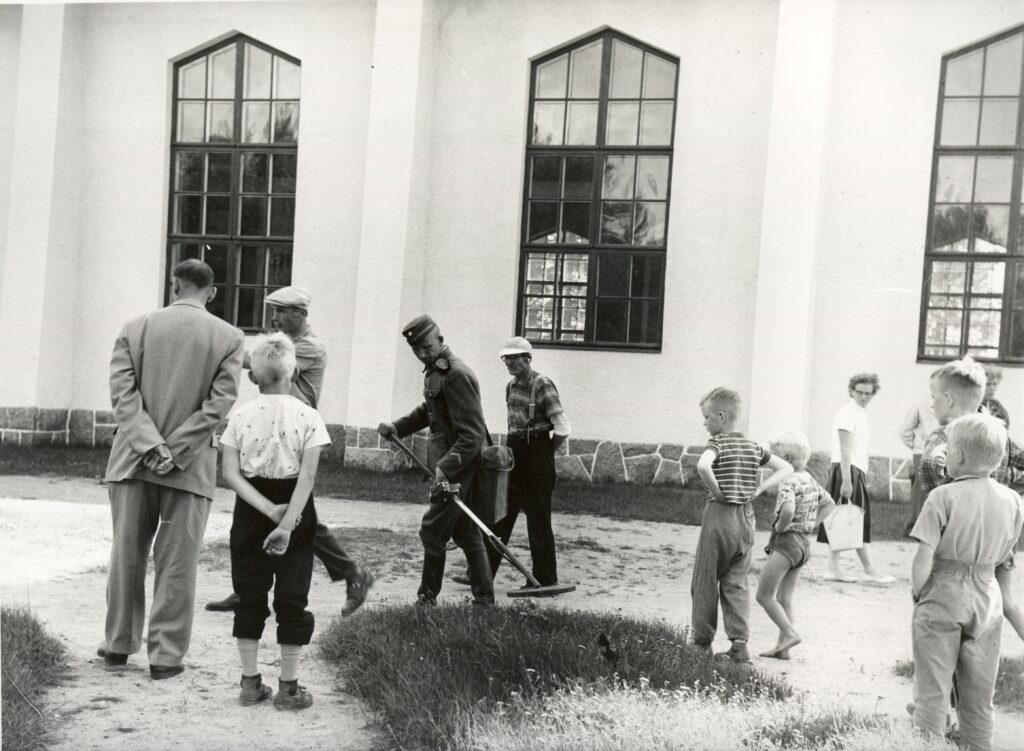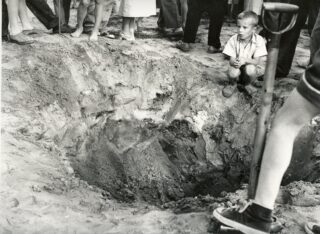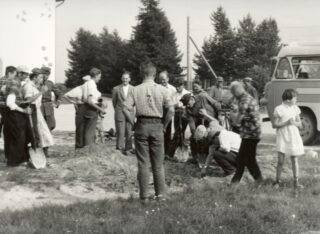In 1959, former commander Schreiber started planning a visit to the graves of his fallen comrades in Finland with a few of his former brothers-in-arms. While bending over the map of Finland, Scheiber suddenly remembered Kuusamo’s bells and realized that they had probably still not been found However, only a few soldiers who knew about the bells were still alive. During the visit, the Germans also decided to take the word about the fate of the bells to Kuusamo. On July 9th, the Germans left with a letter from a German pioneer officer, which read: “The bells are in the third row, the third grave from the left”.
After arriving in Kuusamo, Schreiber and his two companions sought out the vicar, who at first did not believe the Germans’ story. The bells were believed to have been lost to the Russians. However, the search for the church bells began on Wednesday, July 15th.
The first day’s search did not yield results, because after fifteen years and the destruction of the church town, it was difficult to define the exact border of the cemetery or the location of the grave in question. Experts were also in the audience, which had gathered quite a lot. The ground was poked with an iron rod to find the bells. It was hoped to find the place by examining old cemetery maps.
German soldiers also visited the Kuusamo area to pay their respects to their compatriots who fell during the war. Colonel Schreiber made a short speech, which the others listened to while standing straight. After this, the commander laid a simple wreath on the mound of the fallen.
During Wednesday and Thursday, the immediate surroundings of the church and the cemetery were thoroughly investigated. During that time, more interpretations about the possible whereabouts of the bells were made. The third grave in the third row seemed to be suitable for all kinds of terrain. The bells were thought to have been buried in an open grave, which was not common in wartime cemeteries. Instead, there were several open graves in the Heroes’ Cemetery and the German cemetery at that time. The Germans may also have considered the new cemetery a general cemetery, in which case the bells would have been buried there.
In the end, Schreiber suggested that Finnish army pioneers be asked to continue the search with a minesweeper. The Germans themselves already had to continue their journey. A minesweeper was requested from Oulu, the use of which was somewhat questionable, as there was plenty of other metal around the church. However, the minesweeper will signal larger metal deposits with a different sound, so that these points could be marked, probed with sticks, and then possible excavation could be carried out.
The minesweeper was brought to Kuusamo on Saturday evening, July 18th, by first lieutenant Aimo Tiainen and second lieutenant Mikko Kerimaa from Oulu. That same evening, they got to know the church and the cemetery with the guidance of Koillissanomat reporters. The actual work started the next day at 7 a.m. with Second Lieutenant Kerimaa marking the alarm targets for First Lieutenant Tiainen’s sweeps. All alarms were investigated with approximately two-meter iron bars, which were used by sacristan Iisak Palosaari and grave digger Kurvinen. In addition to them, other volunteers also participated in the work. There was also a crowd of several dozen spectators. After the Heroes’ Cemetery, the immediate vicinity of the old belltower was thoroughly investigated, where the metal objects left from the old buildings caused many false alarms. By noon, part of the old cemetery had been explored, but First Lieutenant Tiainen and Second Lieutenant Kerimaa had to return to Oulu, leaving the minesweeper in the custody of Kuusamo’s border company. However, on Sunday, the border company’s men were assigned to firefighting work in Liikanen, so the search was not carried out that day.
The search continued at 1 pm on Monday, July 20th, when the minesweeper was used by border guard Antti Saria. Under the guidance of gravedigger Kurvinen, they searched in places that had yet to be explored, such as the German cemetery behind the Civil War monument, the entire old cemetery, and the immediate surroundings of the church. However, the noticeable alarms turned out to be just pieces of the church’s roof sheet or some other iron object.


